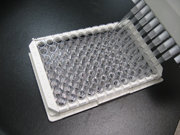Glucose, a sugar found in most organisms, serves as an energy source upon metabolic breakdown and release of ATP. Blood glucose levels in humans are tightly regulated and levels deviating from the normal range can indicate a metabolic problem or disease, such as Diabetes.
Our Glucose Assay Kits measure total glucose present in food or biological samples. Glucose Oxidase first oxidizes glucose, generating hydrogen peroxide that is detected by a probe. The signal produced correlates to the level of glucose in the sample. Glucose levels in an unknown sample are calculated based on a glucose standard curve.

